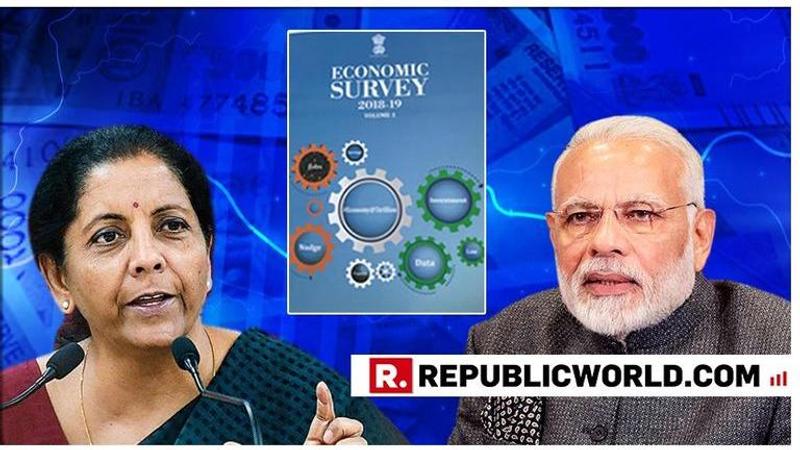Published 15:27 IST, July 4th 2019
This is the Economic Survey 2019's blueprint and tactical plan to turn India into a $5 trillion economy by 2025 as envisioned by PM Modi
The Economic Survey 2019 was tabled by Finance Minister Nirmala Sitharaman in the Rajya Sabha on July 4, Thursday. The economic survey underlined the goals required for achieving the objective of becoming a US$5 trillion economy by 2024-25.

The Economic Survey 2019 was tabled by Finance Minister Nirmala Sitharaman in the Rajya Sabha on July 4, Thursday. The economic survey underlined the goals required for achieving the objective of becoming a US$5 trillion economy by 2024-25.
The main requirement for India to become a 5 trillion economy, as per Economic Survey 2019, is to sustain a real GDP growth rate of 8%. International experience, especially from high-growth East Asian economies, suggests that such growth can only be sustained by a “virtuous cycle” of savings, investment and exports catalysed and supported by a favourable demographic phase. Investment, especially private investment, is the key driver that drives demand, creates capacity, increases labour productivity, introduces new technology, allows creative destruction and generates jobs, highlighted the Economic Survey 2019.
This survey is the first for the new government, which came to power with an overwhelming mandate. The Economic Survey said that India stands at a historic moment when sustained high economic growth has become a national imperative. The Prime Minister had envisioned 5 trillion dollar economy and had said: "If every one of the 130 crore Indians takes one step forward, the country too will go that many steps ahead."
The Economic Survey 2019 also laid out the strategic blueprint for fructifying this vision, the Survey extended its absolute commitment to a collective endeavour. The Economy Survey said that during the last five years India’s economy has performed well. The survey appalauded the several pathways by the government to ensure for trickling-down of the benefits of growth and macroeconomic stability.
Under the following sections in the Economic Survey 2019, the blueprint for the 5 Trillion dollar economy is presented. Here are the excerpts from the EcoSurvey2019:
- THE NEXT FIVE YEARS: A BLUEPRINT FOR GROWTH AND JOBS
- As articulated by the Prime Minister Narendra Modi, India aims to grow into a USD 5 trillion economy by 2024-25, which will make India the third-largest economy in the world. Given 4% inflation, as the Monetary Policy Framework specified by the Government for the Reserve Bank of India, this requires real annual growth rate in GDP of 8 per cent.
- A virtuous cycle of savings, investment, exports and growth with investment as the “central driver”. We depart from traditional thinking by outlining a growth model that views the economy as being in constant disequilibrium a virtuous cycle or a vicious cycle. When the economy is in a virtuous cycle, investment, productivity growth, job creation, demand and exports feed into each other and enable animal spirits in the economy to thrive. In contrast, when the economy is in a vicious cycle, moderation in these variables dampen each other and thereby dampen the animal spirits in the economy.
- Our view of the economy in either a virtuous or a vicious cycle—with investment as the key driver of this cycle—stems from two key departures from the traditional Anglo-Saxon view of the economy. First, the traditional view, which has come under significant challenge following the Global Financial Crisis, considers the concept of equilibrium as a key tenet. In contrast, by imbibing some of the new learning from the economics literature following the Global Financial Crisis, we view the economy as being in a constant state of disequilibrium as captured by a virtuous or a vicious cycle.
- Second, the traditional view often attempts to solve job creation, demand, exports, and economic growth as separate problems. In contrast, as we show below, these macro-economic phenomena exhibit significant complementarities. Therefore, understanding the “key driver” and enhancing the same enables simultaneous growth in each of the other macro phenomena.
- This Survey makes the case for investment as the “key driver” that can create a self-sustaining virtuous cycle in India. This investment can be both government investments in infrastructure, as such investment crowds in private investment and private investment in itself.
Here are the tactics enlisted by the economic survey for achieving 5-trillion dollar economy:
An economy that is in a constant state of dis-equilibrium needs a new approach to navigate. The earlier attempt to create five-year plans, largely using the equilibrium framework, failed because it was too prescriptive for an inherently unpredictable world. Therefore, navigating this uncertain world of dis-equilibrium requires three elements :
(i) a clear vision
(ii) a general strategy to achieve the vision
(iii) the flexibility and willingness to continuosly recalibrate tactics in response to unanticipated situations.
To achieve the goal of 5-trillion dollar economy, the economic survey 2019 elaborates on Caliberation
- Having set out the broad strategy for achieving the goal of a US$5 trillion economy, continuous re-calibration of policies to achieve this goal is necessary.
- Data-driven evidence enables this re-calibration.
- Deng Xiaoping’s exhortation to “cross the river by feeling the stones” is relevant in this context. If the economy in constant disequilibrium represents the flowing river, then data-driven policymaking represents the process of feeling the stones for necessary re-calibration.
- The framework is for creating data “of the people, by the people, for the people.”
Updated 17:05 IST, July 4th 2019




